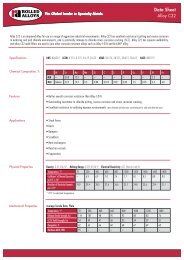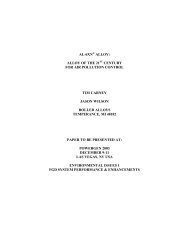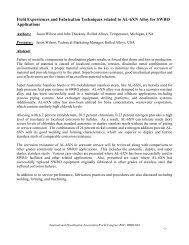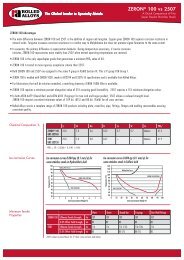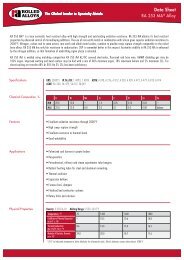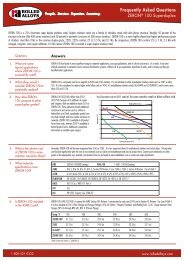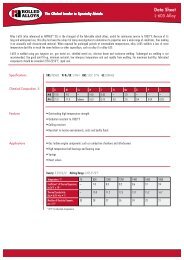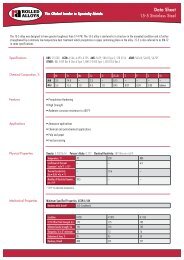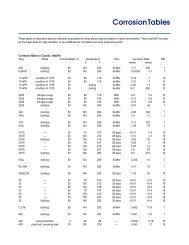2205 Data Sheet.indd - Rolled Alloys
2205 Data Sheet.indd - Rolled Alloys
2205 Data Sheet.indd - Rolled Alloys
- No tags were found...
You also want an ePaper? Increase the reach of your titles
YUMPU automatically turns print PDFs into web optimized ePapers that Google loves.
5Sigma phase will precipitate upon exposure to temperatureswithin the 1300-1800°F range. Precipitation occurs most rapidlyat 1600°F. The presence of sigma phase will cause both a loss inroom temperature ductility and a reduction in corrosion resistance.<strong>2205</strong> mill products are evaluated in accordance with ASTM A 923and are free of harmful levels of intermetallic phases.The welding of <strong>2205</strong> does subject the heat affected zone (HAZ)of the joint to the sigma formation temperature range. The highnitrogen content of <strong>2205</strong> slows the precipitation of intermetallicphases so that welding can be performed without the formation ofharmful levels of sigma phase formation.Exposure to temperatures in the 650-980°F range causes theprecipitation of alpha prime in the ferritic portion of the material.This phenomenon is also referred to as 885°F embrittlement.During welding the time at temperature is typically not longenough to cause embrittlement. 885°F embrittlement limits theuse of <strong>2205</strong> to temperatures below 600°F.FABRICATIONHot FormingHeat <strong>2205</strong> uniformly to 2050-2100°F (1120-1150°C). Do not forgeat temperatures below 1740°F (950°C). Reheat as often asnecessary. Hammer forging is preferred. Dies should havegenerous radii. Cool forgings in air and anneal, followed by waterquench.Hot tearing or surface checking are possible if the initial forgingtemperature is too high. As with other high chromium alloys, <strong>2205</strong>can be sensitive to coarse grinding marks on the forging billet.In order to dissolve undesirable precipitates occurring from the hotforming operations, and to restore the austenite-ferrite balance,the fi nished forging should be heat treated at 1950°F (1070°C)minimum for 10 minutes, or 30 minutes per inch (25mm) ofthickness, water quenched. Rapid heat-up rate is desired to avoiddeveloping second phases. This alloy has very low strength at theannealing temperature, so the workpiece should be wellsupported in the furnace. It is important to cool to below 700°F(370°C) as quickly as possible. If the cooling rate is too slow, itwill lead to decreased corrosion resistance and lowered impactstrength.Cold Forming<strong>2205</strong> stainless can be readily formed and cold worked usingtechniques and designs similar to the basic austenitic stainlesssteel grades. However, due to higher strength and slightly lowerductility, bend radii must be more generous than those used foraustenitic materials. Power requirements for forming operationswill be greater due to the higher yield strength of <strong>2205</strong> stainlessas compared to standard austenitic stainless.<strong>2205</strong> stainless plate can normally be press brake bent over aradius equal to twice the plate thickness. As with other stainlessand nickel alloys, bending over a sharp male die may causethe material to crack. Annealing may be required after 15% colddeformation.Welding ConsumablesGMAW, GTAW and SAW bare wire produced to AWS A5.9,ER2209 (UNS S39209)Nominal Chemistry: 22.5 Cr; 8.5 Ni; 3.1 Mo; 1.6 Mn; 0.4Si; 0.14 NSMAW covered electrodes produced to AWS A5.4, E2209(UNS W39209)Nominal Chemistry: 22.5 Cr; 9.5 Ni; 3.1 Mo; 0.9 Mn; 0.14 NFCAW gas-shielded fl ux cored wire produced to AWS A5.22,E2209-T0-1 and E2209-T1-1 (UNS W39239).Nominal Chemistry: 22.5 Cr; 9.0 Ni; 3 Mo; 1.3 Mn; 0.10 NHeat TreatmentSolution annealing is performed in the range 1870-2010°F(1020-1100°C). Fixture the workpiece to minimize distortion, asthis alloy has low strength at the annealing temperature. The aimpoint for <strong>2205</strong> stainless is 1950°F (1066°C) for at least 10minutes, or 30 minutes per inch (25mm) of thickness, followed bya water quench. Water quench is mandatory. Furnace or aircooling of <strong>2205</strong> stainless is defi nitely not recommended, andwould result in unacceptable mechanical and corrosion properties.Shielded Metal Arc Welding (SMAW)Table 5 - Typical SMAW ParametersElectrodeCurrent,VoltageDiameterAmperes3/32 inch (2.4mm) 50-80 22-281/8 inch (3.2mm) 80-120 22-285/32 inch (4.0mm) 100-160 22-283/16 inch (4.8mm) 160-220 22-28Gas Metal Arc Welding (GMAW)<strong>2205</strong> plate is GMA welded using either the spray arc or pulsed-arctransfer mode. Short circuiting arc transfer is used for welding thinsheets and for out-of-position welding. Pulsing arc transferprovides some of the benefi ts of spray arc at a lower average heatinput, which permits the method to be used on sheet gauges andin all positions. Heat inputs should be maintained around 20-45kJ/inch (0.8-1.8 kJ/mm). The upper end of the range is not critical.Shielding gas is normally 100% welding grade argon having anominal purity of 99.996% and a dew point of -77°F (-60°C).2% nitrogen may be added. Helium may be added if desiredto fl atten the bead contour. Argon-25% helium is desirable to


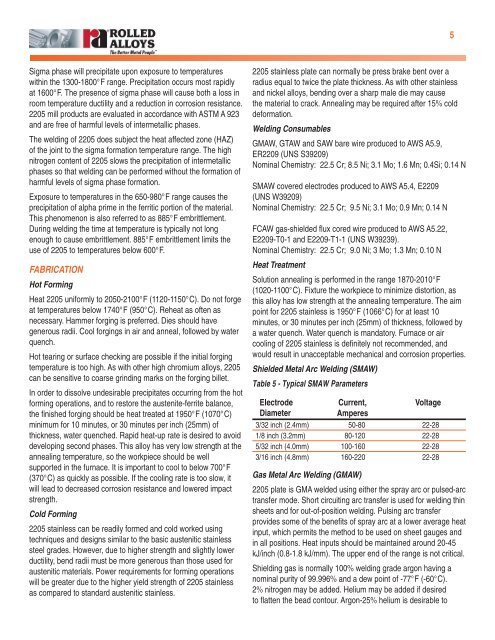
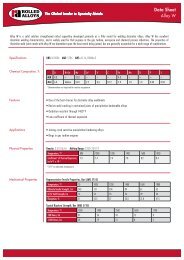
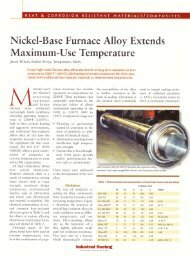
![RA333 Data Sheet [Heat Resistant Alloys] - Rolled Alloys](https://img.yumpu.com/50335849/1/190x245/ra333-data-sheet-heat-resistant-alloys-rolled-alloys.jpg?quality=85)
